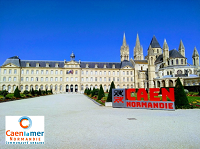Orateur
Description
Quantum phase transitions (QPTs) in atomic nuclei are drastic structural changes in the spectrum that are identified as either shape evolution or crossing shell model configurations in a chain of nuclei as a function of nucleon number. This phenomenon is frequently investigated in nuclear physics, both theoretically and experimentally, where many rare isotope beam facilities investigate a plethora of nuclei.
In this talk I will discuss my attempt to understand such phenomenon using algebraic frameworks - the interacting boson model with configuration mixing for even-even nuclei, and the new interacting boson-fermion model with configuration mixing for odd-mass nuclei. I will present my work on the chain of zirconium isotopes ($Z = 40$) with mass numbers A = 92-110 and the chain of niobium isotopes (Z = 41) with mass numbers A = 93-103. The spectrum of the two chains discloses the manifestation of intertwined quantum phase transitions (IQPTs). IQPTs represent a situation where two types of QPTs occur in the same chain of nuclei. One is a crossing of two configurations in the ground state, and another is a shape evolution within each configuration. The occurrence of IQPTs in both chains of isotopes can set path for new investigations of this phenomenon in other chains, both even-even and odd-mass.

